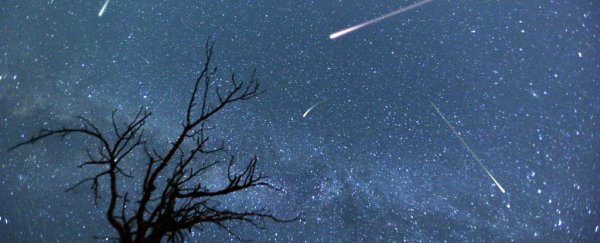If you're as much of a sucker for a good sky-watching event as we are, you're not gonna want to miss this year's Perseid meteor shower.
Experts are predicting that, at its peak on August 11-12, we're going to get twice as many meteors that usual, and when it comes to the Perseids, that's a hell of a lot.
"Forecasters are predicting a Perseid outburst this year with double normal rates on the night of August 11-12," Bill Cooke of NASA's Meteoroid Environments Office said in a statement. "Under perfect conditions, rates could soar to 200 meteors per hour."
Just to put that in perspective, in a regular year, we usually only get 80 meteors per hour during the Perseids.
So how come we get twice the fun this year? As much as we'd like to think of meteor showers like this and the Eta Aquarids as visiting us every year, it's actually us visiting the meteor showers.
The Perseids occur when Earth's orbit brings us into the path of Comet Swift-Tuttle, and usually we only make it into the very edges the debris trail it sheds as it zooms through space.
But this month is likely to be different, as Eric Mack explains for CNet: "[T]his could be the rare year where Jupiter's gravity tugs that stream a little closer, allowing our planet to plow right through the middle of it, where there's more junk and we see more meteors as a result."
Earth has already started to pass through the path of Comet Swift-Tuttle, and is expected to continue shadowing it until August 24.
Although its peak is between August 11 and 12, that just means you'll see the most meteors in the shortest amount of time. If you're really keen, you can start trying to spot them now, traveling at whopping speeds of around 60 km (37 miles) per second.
As Sarah Lewin over at Space.com advises, if you're in the Southern Hemisphere, the meteors should originate in the sky from the constellation Perseus, which appears on the horizon at about 10pm ET (7pm PT). But if you want the best show, try to stay up until after midnight.
"They can appear all over the sky, but they will always look like they're streaking away from Perseus," she says.
While the Northern Hemisphere will definitely get the better view, for our Australian readers, the peak will occur on August 12 to 13, and your best chance to see them will be up north, in Darwin, Cape York, Cairns, and the Tiwi Islands.
And if you want to see it all from the comfort of your couch, you can catch a live NASA broadcast on the Ustream below on the nights of August 11-12 and August 12-13, from beginning at 10pm ET (7pm PT, or 12pm on August 12 AEST).
Happy sky-watching!
